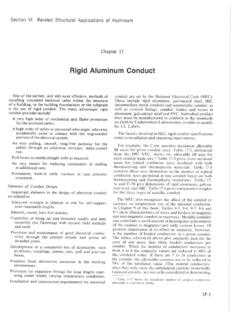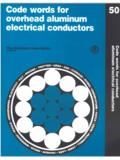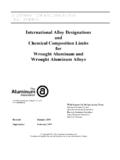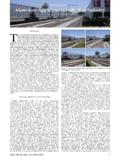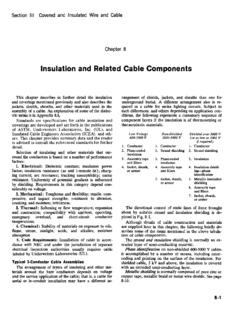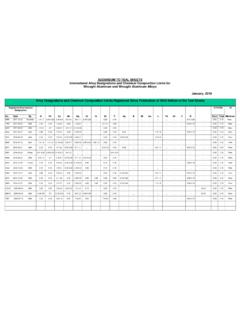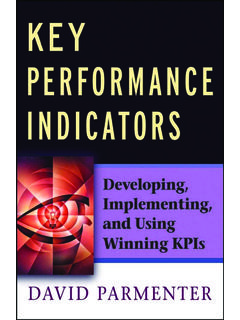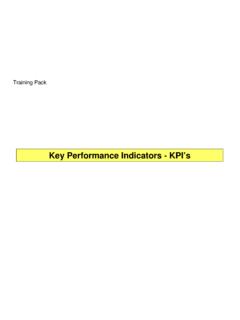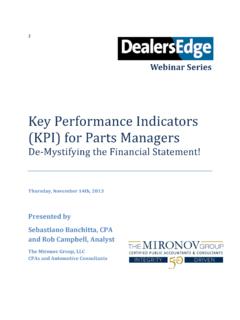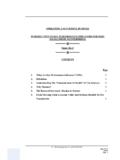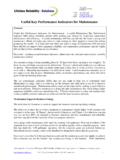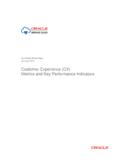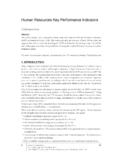Transcription of The Aluminum Can Advantage Key Sustainability …
1 The Aluminum Can Advantage Key Sustainability performance Indicators June 2017. Introduction As the leading voice for the Aluminum industry in North America, the Aluminum Association is committed to providing up-to-date, complete and accurate information on industry Sustainability . To that end, we are releasing a comprehensive report on key Sustainability performance indicators (KPI) for one of our best-known and widely used consumer products the Aluminum can. Aluminum can scrap is a vital input for the industry and allows can manufacturers to make beverage containers in the most environmentally friendly and economical way possible. It takes just 8 percent of the energy to produce Aluminum from recycled material compared to producing new, or primary, In addition, Aluminum 's recycling profile and the high value of the material means that, unlike competing packages like glass and plastic bottles, the Aluminum used beverage container (UBC) is most often recycled directly back into itself.
2 This process occurs over and over again without degradation in product quality. This closed-loop process drives a virtuous cycle of high recycling rates, a large percentage of recycled content in the average Aluminum can and an economically sustainable process that effectively subsidizes municipal recycling programs nationwide. In partnership with our member companies which are responsible for all of the Aluminum can sheet production and most of the Aluminum UBC recycling in the United States today the Aluminum Association has developed a series of KPIs as well as comparative information to provide a complete picture of the Aluminum can's Sustainability performance . The indicators include: Industry Recycling Rate: Measures the amount of used Aluminum can scrap recycled by Aluminum producers as a percentage of cans shipped. This rate provides a measure of industry efficiency relative to overall can shipments.
3 This rate includes both domestic and imported can scrap from foreign countries that is reclaimed by producers as well as used cans that are exported and recycled overseas. The rate is unique to the Aluminum industry. Consumer Recycling Rate: Measures the amount of Aluminum can scrap recycled domestically as a percentage of cans available for recycling in the In order to provide a more accurate representation of consumer recycling behavior, the consumer rate excludes imported can scrap and also accounts for the movement of unfilled cans into/out of the The rate is one indication of how well municipal recycling programs are performing nationwide, though it can still be impacted by year-to-year fluctuations in metal flows and commodity prices. 1. Aluminum Can KPI Report June 2017. Additionally, the rate provides an indication of how much Aluminum can scrap is either landfilled, held in inventory, or has otherwise fallen outside the association's tracking system.
4 Recycled Content: Measures the proportion of recycled Aluminum versus virgin Aluminum in the average Aluminum can. The recycled content rate is one indicator of environmental stewardship of the Aluminum can. Value of Material: Measures the dollar value per ton of Aluminum can scrap. The value of material measure indicates the relative importance of different materials commonly found in the recycling bin to sustaining the financial viability of municipal recycling programs. The data is based on a two-year rolling average of commodity prices for competing material types. Weight: Measures the weight of the average Aluminum can. This measure is an indicator of overall material efficiency and functionality for beverages packaged in Aluminum cans. Producing a lighter container for the same volume of beverage indicates significant engineering improvements in can making and efficiency improvements in source reduction and material utilization.
5 For comparative purposes, the data has been normalized on a gram of material per ounce of beverage basis. Aluminum Can KPI Report June 2017. Summary Results Following are top-level results for key Sustainability performance indicators of the Aluminum can compared to other beverage packaging options. Aluminum Cans Glass Bottles Plastic Bottles (PET). Industry N/A N/A. Recycling Rate2. Consumer Recycling Rate3. Recycled 70% 23% 3%. Content4. Value of $1,186/ton -($17)/ton $226/ton Material5. Weight6 (gram of grams grams grams material per oz of bev). 2. No equivalent data available for glass or plastic bottles. 3. Data for glass and plastic via the Environmental Protection Agency (EPA) Advancing Sustainable Materials Management 2014 Fact Sheet : 11/ and NAPCOR Postconsumer PET Container Recycling Activity in 2015 report This is the latest publicly available information for glass and plastic.
6 The EPA report typically lags for about 2 years in terms of latest available statistics. 4. Data for all three containers have not changed since the 2015 KPI report. Data for glass and plastic via the Environmental Protection Agency (EPA) Individual Waste Reduction Model (WARM): 5. Data based on a two-year rolling average of commodity prices from February 2015 February 2017 for various material types via 6. Data for Aluminum produced in coordination with the Can Manufacturers Institute. Data for glass and plastic estimated based on publicly available information. Plastic (PET) from study by American Samoa Power Authority Materials Management Office (includes bottle cap in calculation): 0 VENTURE%20 RECYCLING-Appendix% ; Glass from Waste 360: Aluminum Can KPI Report June 2017. Industry Recycling Rate Background The industry recycling rate indicates the amount of Aluminum can scrap recycled by Aluminum producers as a percentage of finished cans shipped by the industry during a one-year time period.
7 In basic terms, the rate provides an indication of industry stewardship and efficiency in managing the metal. This rate includes imported can scrap as well as used beverage cans that are exported and recycled overseas. Imports in particular have become an increasingly important feedstock for can recyclers in recent years. The quantity of scrap recycled is measured directly at the point where processed UBCs are fed into melting furnaces. This means that the Aluminum is truly recycled, not simply available for recycling the standard for some material recycling rates. Also, Aluminum cans are most often recycled in a closed loop while glass and plastic are often down- cycled into other products such as road pavement or carpet fiber. Though the recycled material in these cases is diverted into another product for some period of time, it will ultimately end up in the landfill.
8 Aluminum , by contrast, is generally recycled directly back into itself and, accordingly, never has to end up in a landfill. The industry recycling rate declined by about four-tenths of one percent in 2016 to percent. The change is largely the result of a modest year-over-year drop in the volume of UBCs consumed by the domestic industry, as well as a large drop in UBC exports. At the same time, imports of UBCs grew by nearly one-third in 2016 for the largest volume of UBC imports since tracking began. Continued low metal and scrap prices as well as a strong dollar contributed to the drop in domestic UBCs consumed and consequent increase in imports. The 2016 industry recycling rate remains above its ten-year average of percent. Aluminum Can KPI Report June 2017. Methodology The Aluminum Association industry recycling rate is based on survey input of UBC melting facilities including can sheet producers, can manufacturers and secondary producers of Aluminum , representing nearly all can recycling activity in the United States.
9 The calculation to determine the rate is as follows: (Pounds of UBC Melted Domestically7 + Pounds of UBC Exports8) =. Pounds of Cans Shipped by Producers9. Pounds of Cans Recycled by Industry =. Pounds of Cans Shipped by Producers Billion Pounds of Cans Recycled = Billion Pounds of Cans Shipped 7. Input weight of used beverage can scrap melted during the year. Figures derived from survey of Aluminum mills and secondary producers conducted by Aluminum Association and Institute of Scrap Recycling Industries. Estimated full coverage. Includes imported UBCs since mills purchase scrap from scrap processors, brokers and traders who do not identify source. 8. Foreign Trade Division. Bureau of the Census, Department of Commerce. Trade statistics derived from Customs reports. HTS 7602000030: Aluminum beverage container scrap. HTS 7612901030: Aluminum cans of a capacity not exceeding 355 ml.
10 9. Survey of can manufacturers conducted by Can Manufacturers Institute. Reported shipments of Aluminum beverage cans lagged one quarter. Estimated full coverage - Includes exports. Aluminum Can KPI Report June 2017. Industry Recycling Rate Calculation History 2011 2012 2013 2014 2015 2016. Pounds of UBC. Melted Domestically (MMlbs) 1, 1, 1, 1, 1, 1, + Pounds of UBC Exports (MMlbs) = Pounds of Cans Recycled (MMlbs) 1, 1, 1, 1, 1, 1, / Pounds of Cans Shipped by Producers (MMlbs) 2, 2, 2, 2, 2, 2, = Industry Recycling Rate Aluminum Can KPI Report June 2017. Charts & Graphs Industry Recycling of Aluminum Cans Through the Years 2016 =. 80%. Industry Recycling Rate 70%. 60%. 50%. 40%. 30%. 20%. 10%. 1988. 2002. 2016. 1972. 1974. 1976. 1978. 1980. 1982. 1984. 1986. 1990. 1992. 1994. 1996. 1998. 2000. 2004. 2006. 2008. 2010. 2012. 2014. The Aluminum industry recycling rate has risen steadily over the last 40 years.
